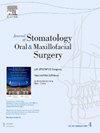HPV 相关扁桃体癌对侧隐性颈部转移的影响:是否需要进行选择性对侧颈部切除?
IF 1.8
3区 医学
Q2 DENTISTRY, ORAL SURGERY & MEDICINE
Journal of Stomatology Oral and Maxillofacial Surgery
Pub Date : 2024-11-07
DOI:10.1016/j.jormas.2024.102140
引用次数: 0
摘要
背景:人类乳头瘤病毒(HPV)相关扁桃体癌的对侧选择性颈部切除术是一个争论的问题:人乳头瘤病毒(HPV)相关扁桃体癌的对侧选择性颈部切除术是一个有争议的问题:本研究旨在分析对侧淋巴结(LN)转移率及其对HPV相关扁桃体癌预后的影响。我们还评估了选择性对侧颈部切除的必要性:方法:为了研究采用前期原发手术和双侧颈部切除术治疗的 HPV 相关性扁桃体癌中对侧结节病的病理发生率和风险因素,我们回顾了 68 例患者的病历:结果:6 名患者(8.8%)出现了病理上的对侧结节病;其中 4 名患者的 LN 转移证实发生在对侧 II 层,1 名患者的 LN 转移发生在 III 层,1 名患者的对侧 II 层和 III 层出现了多层次转移。对侧淋巴结转移与原发肿瘤侵犯深度(DOI)(P=0.032)、阳性淋巴结数量(P=0.008)和同侧颈部阳性淋巴结比例(P=0.01)显著相关。有对侧LN转移的患者五年总生存率明显较低,但无病生存率无明显差异:结论:HPV相关性扁桃体癌的隐匿性对侧LN转移率极低。结论:HPV相关性扁桃体癌的隐匿性对侧LN转移率极低,但在同侧多发结节转移和DOI较高的病例中,值得根据隐匿性转移的风险考虑选择性对侧颈部切除。本文章由计算机程序翻译,如有差异,请以英文原文为准。
Impact of contralateral occult neck metastasis in HPV-associated tonsil cancer: Is elective contralateral neck dissection required?
Background
Contralateral elective neck dissection in human papillomavirus (HPV)- associated tonsil cancer is a matter of debate.
Objectives
The aim of this study was to analyze rates of contralateral lymph node (LN) metastasis and their prognostic effects on HPV-associated tonsil cancer. We also assessed the necessity of elective contralateral neck dissection.
Methods
To investigate the pathologic incidence of and risk factors for contralateral nodal disease in HPV-associated tonsil cancer treated with upfront primary surgery and bilateral neck dissection, the records of 68 patients were reviewed.
Results
Six (8.8%) patients displayed pathologic contralateral nodal disease; four of the patients had LN metastasis confirmed in contralateral level II, one patient had LN metastasis in level III, and one patient had multi-level metastasis in contralateral levels II and III. Contralateral LN metastasis showed a significant association with greater depth of invasion (DOI) in primary tumor (p = 0.032), count of positive LN (p = 0.008), and positive LN ratio of the ipsilateral neck (p = 0.01). Patients with contralateral LN metastasis showed a significantly worse five-year overall survival but no significant difference in disease-free survival.
Conclusion
HPV-associated tonsil cancer has exceedingly low rates of occult contralateral LN metastasis. However, in cases of ipsilateral multiple node metastases and higher DOI, it may be worth considering elective contralateral neck dissection based on the risk of occult metastasis.
求助全文
通过发布文献求助,成功后即可免费获取论文全文。
去求助
来源期刊

Journal of Stomatology Oral and Maxillofacial Surgery
Surgery, Dentistry, Oral Surgery and Medicine, Otorhinolaryngology and Facial Plastic Surgery
CiteScore
2.30
自引率
9.10%
发文量
0
审稿时长
23 days
 求助内容:
求助内容: 应助结果提醒方式:
应助结果提醒方式:


